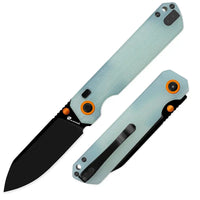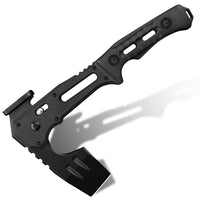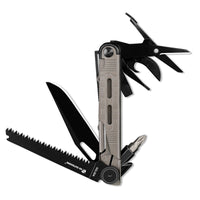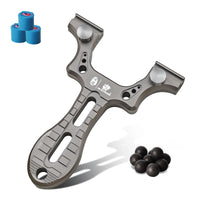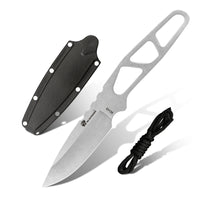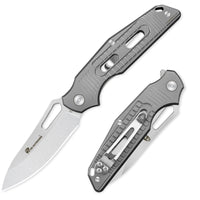Premium 14C28N Blade · Latest Button Lock · Improved Design
Now $35.99 (Was $49.99)

Blade Selection Guide: Discover 17 Unique Blades Styles
As you embark on your quest for the perfect knife, you've likely considered the intricacies of blade steel, handle materials, lock mechanisms, and opening methods to ensure your blade is both functional and stylish. However, amidst all these considerations, one crucial element often goes overlooked: the blade shape. The shape of the blade is the heart and soul of the knife, dictating its optimal use. With a plethora of options ranging from the traditional clip point to the unconventional hawksbill, each blade shape possesses distinct advantages.
In this piece, we delve into 17 prominent blade profiles, delving into their unique characteristics and recommended applications. By the conclusion of this exploration, you'll possess a comprehensive understanding of how blade shape impacts a knife's performance and the expertise needed to select the ideal blade for your specific requirements. Let's delve into the details and discover the blade that perfectly suits your needs.
1. Drop Point
The drop point blade shape is a popular and widely used design in modern knives, characterized by a convex curve on the top of the blade that slopes downward toward the point. This design creates a strong, sharp point that is great for general purpose use and tasks that require versatility. Drop point knives are known for their durability and are often used for hunting, outdoor activities, and everyday tasks. The drop point design makes them suitable for tasks such as skinning, slicing, and piercing. The broader tip shape of the drop point design helps prevent breakage, making it a versatile choice for various cutting applications.

2. Clip Point
Clip point knives are a style of knife blade with a concave curve near the tip, creating a sharper point. The clip point design allows for more precision and control when cutting, making them popular for tasks that require detailed or fine cutting. These knives are commonly used for hunting, camping, and everyday tasks. The thin and sharp tip of the clip point blade excels at piercing objects and intricate tasks. Due to its slender design, the tip of the clip point blade may be more delicate compared to other blade styles. Embraced by outdoorsmen and hunters for many years, the clip point blade has demonstrated its reliability and versatility for various cutting tasks.

3. Tanto
A tanto knife is a Japanese-style blade that is characterized by a straight edge and a flat grind, with little or no curve on the cutting edge. The tanto blade typically has a high point near the front of the blade, which allows for strong and precise stabbing and piercing capabilities. The tanto knife design was originally developed for armor-piercing purposes in feudal Japan, but it has since become popular in modern tactical and utility knives.
The tanto design typically features a distinct chisel tip, which provides added strength and durability for piercing hard materials. Tanto knives are known for their strength, durability, and versatility, making them well-suited for a variety of tasks, including cutting, and piercing.
Although the angled tip of the tanto blade offers impressive strength, it does come with some limitations. The sharp angle of the blade diminishes its slicing capabilities, and sharpening a tanto blade requires more effort compared to sharpening curved blades.

4. Reverse Tanto
A reverse tanto blade, also known as a modified tanto or American tanto, is a type of knife blade that features a straight cutting edge with a front edge that angles down towards the tip in a reverse manner compared to a traditional tanto blade. The spine of the blade typically has a straight or slightly curved contour.
Reverse tanto blades combine the strength and durability of a tanto blade with the cutting versatility of a drop point blade. The angular tip of the reverse tanto blade allows for powerful thrusting and piercing capabilities, while the straight edge provides a longer cutting surface for slicing tasks.
Distinguished by the unique angle at the top of the blade rather than the belly, the reverse tanto excels in slicing tasks while still maintaining a robust tip for piercing purposes.

5. Straight-Back
A standard or straight-back blade refers to a type of knife blade that has a straight spine that runs parallel to the cutting edge from the handle to the tip. The blade does not have any curves, angles, or dips along its edge, giving it a simple and uniform appearance.
The straight-back blade design is versatile and well-suited for a variety of cutting tasks. Its straight edge makes it efficient for slicing, chopping, and other general cutting needs. The continuous curve from the handle to the tip provides a consistent cutting surface, which can be useful for maintaining control and precision during use.
Straight-back blades are commonly found in various types of knives, including kitchen knives, hunting knives, utility knives, and everyday carry knives. The standard blade, not tailored for any specific task, so it's able to do just about anything. While its appearance may not be flashy, simplicity can often be the most effective choice.
6. Spear Point
Spear point knives are blade designs that have symmetrical double edges that taper to a point. This design resembles the shape of a spearhead, with a central point and two sharp edges that come together symmetrically. The blade is typically flat or slightly concave on both sides. Spear point knives are known for their piercing capabilities, making them ideal for stabbing and thrusting motions. These knives are often used for self-defense, tactical purposes, and general utility tasks where precise cutting and piercing are required.
The distinction between spear point blades and dagger blades can sometimes be ambiguous, as they are often used interchangeably. Therefore, the most obvious difference is that the spear point has a sharp tapered blade design, while the dagger has a double-edged wider blade design.

7. Dagger
A dagger is a type of knife with a double-edged blade that is symmetrical in shape, tapering to a sharp point. Daggers are designed primarily for thrusting and stabbing, rather than cutting. They are often associated with combat, self-defense, and ceremonial purposes. Daggers have a long history and have been used by various cultures and civilizations throughout time.
The double-edged blade of a dagger makes it a versatile and deadly weapon, capable of inflicting serious injuries. Daggers can vary in size, from small personal defense daggers to larger, ceremonial or combat daggers. While dagger knives exude a formidable and striking appearance, they are primarily intended for use as stabbing weapons and lack versatility for everyday tasks.
8. Kukri
A kukri is a type of large, curved knife that originates from Nepal. It is traditionally used as both a tool and a weapon by the Gurkha soldiers of Nepal. The kukri features a distinctive inwardly curved blade that widens towards the tip, providing a forward-weighted design that enhances chopping and slashing capabilities.
The kukri's design allows for versatile use in various tasks such as chopping wood, clearing brush, preparing food, and even combat situations. The curve of the blade provides a powerful chopping action while the pointed tip can be used for piercing and stabbing.
The kukri has a rich history and cultural significance in Nepal, where it is often seen as a symbol of bravery and prowess. It is also a popular collectible and outdoor tool used by hikers, campers, and survivalists for its practicality and effectiveness.

9. Hawksbill
The Hawksbill blade is a unique and distinctive blade shape. It features a sharply curved edge that tapers to a fine point, resembling the beak of a hawk or the bill of a turtle. This blade shape is excellent for tasks that require precise and controlled cutting, such as detailed work, slicing through materials with ease, and making intricate cuts. The curved edge of the Hawksbill blade allows for excellent control and maneuverability, making it a favorite among knife enthusiasts for specific cutting tasks, such as cutting cords, stripping wires, pruning plants, and trimming carpet with precision and ease.

10. Sheepsfoot
Sheepsfoot blades are known for their safety and precision in cutting tasks due to the lack of a pointed tip. The design of the blade makes it ideal for tasks that require controlled cuts without the risk of accidental punctures or slips. This makes sheepsfoot blades popular in situations where safety is a priority, such as emergency rescue operations, electrical work, and woodworking.
The straight cutting edge of the sheepsfoot blade provides excellent slicing and chopping capabilities, making it a versatile choice for a wide range of applications. Sheepsfoot blades are commonly found in utility knives, everyday carry knives, and rescue tools due to their practical and functional design.

11. Gut Hook
A gut hook is a specialized type of blade feature commonly found on hunting knives and skinning knives. It consists of a small, curved hook located on the spine of the blade near the tip. The purpose of the gut hook is to assist in field dressing game animals by making it easier to open the abdominal cavity without puncturing the intestines or other internal organs.
The gut hook is typically used by making a small incision with the main blade and then inserting the hook into the incision to unzip the skin and abdominal cavity with ease. This helps hunters to cleanly and efficiently remove the internal organs while minimizing the risk of contaminating the meat.
Gut hooks are particularly popular among hunters and outdoor enthusiasts who frequently field dress game animals as they can speed up the dressing process and help preserve the quality of the meat. They are also commonly used for other tasks such as cutting rope, opening packages, or performing other precise cutting tasks.
12. Wharncliffe
A Wharncliffe blade is a type of knife blade characterized by a straight edge that curves slightly upwards to meet a straight, pointed tip. The spine of the blade runs parallel to the cutting edge, creating a triangular profile that is similar to a tanto blade but with a more gradual curve. Due to the necessity for precise slicing and cutting tasks over stabbing and piercing, the Wharncliffe style blade was initially crafted for whittling and everyday carry duties. Known for their shorter length, substantial thickness, and impressive durability, Wharncliffe blades have gained a reputation for their sturdiness.
Wharncliffe blades are popular in utility and everyday carry knives due to their versatile cutting capabilities. The straight edge makes it easy to control the cut and offers precise slicing, making it particularly useful for tasks that require accuracy and detail.
13. Trailing Point
A trailing point blade is a type of knife blade that features a sweeping, upwardly curved cutting edge that extends beyond the spine of the blade. The tip of the blade curves upward, creating a "trailing" point that is positioned higher than the handle of the knife. This design gives the blade a unique and elegant appearance.
The trailing point blade design is well-suited for tasks that require precision and control, such as slicing and skinning. The curved cutting edge provides a long, sweeping belly that allows for efficient slicing and cutting motions. The tip of the blade is positioned higher, making it great for delicate and detailed cutting tasks.
Trailing point blades are commonly found in hunting knives, fillet knives, and other specialized cutting tools where precision and fine cutting control are essential. The unique shape of the trailing point blade makes it a popular choice among outdoor enthusiasts, fishermen, and anyone who requires a knife that excels at slicing, skinning, and intricate cutting tasks. However, their thin structure makes them prone to bending or breaking when applied to more durable materials.
14. Cleaver
A cleaver blade is a thick, heavy, and rectangular blade commonly found on cleaver knives. It is designed for chopping, slicing, and dicing meat, poultry, and vegetables with ease and precision. The wide blade of a cleaver offers excellent leverage and power, allowing for efficient cutting through bones and tough cuts of meat.
Cleaver blades are typically made from high-quality stainless steel or carbon steel, known for their durability and sharpness. The unique shape of the cleaver blade makes it a versatile tool in the kitchen and a favorite among professional chefs and home cooks for various culinary tasks.

15. Harpoon
A harpoon blade is a uniquely shaped knife blade that resembles the tip of a harpoon. It features a long, pointed, triangular blade that tapers to a sharp point, resembling the shape of a harpoon used for hunting fish or whales. Harpoon point blades are characterized by an upward ramp on the spine that resembles the barbs on whaling harpoons, which is where they get their name from.
Harpoon blades are often found on specialized hunting and fishing knives, as well as some tactical and survival knives. The shape of the blade is designed to provide excellent piercing capabilities and precision cutting when performing tasks such as skinning, gutting, or filleting game or fish.
Additionally, the unique design of the harpoon blade adds visual appeal to knives and makes them stand out in any collection.

16. Kriss
A Kriss, also known as a Kris or Keris, is a type of asymmetrical dagger that originates from Southeast Asia, particularly Indonesia, Malaysia, and the Philippines. The Kriss is characterized by its distinctive wavy blade with intricate designs and patterns, often believed to possess mystical or spiritual qualities.
The Kriss blade is typically double-edged, with a unique wavy pattern that is created through a process of layering different types of metal. This design is not only aesthetically pleasing but also serves a practical purpose by increasing the blade's cutting ability and penetration.
17. Bowie
A Bowie knife is a large, fixed-blade knife that is commonly used for hunting, camping, and general outdoor activities. It is known for its distinctive design, with a clip point blade that is typically around 8-12 inches in length. The Bowie knife is named after American frontiersman Jim Bowie, who famously used a similar style knife in a duel known as the Sandbar Fight in 1827. Bowie knives are popular among collectors and outdoor enthusiasts for their rugged durability and classic design.

